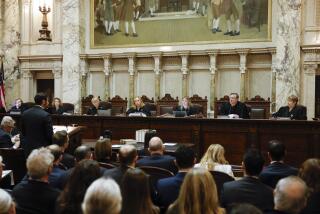Op-Ed: Is the Supreme Court finally ready to tackle partisan gerrymandering? Signs suggest yes
Is the Supreme Court about to cause great political upheaval by getting into the business of policing the worst partisan gerrymanders? Signs from last week suggest that it well might.
At the very beginning of its term back in October, the court heard oral arguments in Gill vs. Whitford, a case challenging Wisconsin’s plan for drawing districts for its state Assembly. Republican legislators drew the lines to give them a great advantage in these elections. Even when Democrats won more than a majority of votes cast in the Assembly elections, Republicans controlled about 60% of the seats.
The court has for many years refused to police such gerrymandering. Conservative justices suggested that the question was “nonjusticiable” (meaning the cases could not be heard by the courts) because there were no permissible standards for determining when partisanship in drawing district lines went too far. Liberals came forward with a variety of tests. And Justice Anthony M. Kennedy stood in the middle, as he often does. He argued that all the tests liberals proposed didn’t work, while trying to keep the courthouse door open for new tests.
The ‘efficiency gap’ measures wasted votes, or votes cast that do not contribute to victory.
Gill offers one: It’s called the efficiency gap and it measures wasted votes, or votes cast that do not contribute to victory. (The more of these a party has to swallow, the less likely it is to win.) People reading the tea leaves during Gill oral arguments seemed to think that Kennedy was sympathetic to the Wisconsin challengers.
So far there has been no word on the outcome from the court, which issues decisions in its hardest cases as late as the end of June. There was, however, a tantalizing development late last week when the court agreed to hear a gerrymandering case out of Maryland this term. Benisek vs. Lamone involves a single congressional district drawn by Democrats to make it harder for Republicans to elect a member of Congress.
Setting a case like this for full argument is unusual. Ordinarily, when a second case presents an issue similar to one the court is already considering, the justices hold the second until the first has been decided, and then send it back to the lower court for further proceedings.
So what’s going on?
Maybe there is some technical problem with the Gill case — such as a lack of standing for the plaintiffs — that would prevent the court from deciding it on the merits. Maybe the court will rule that these cases must be decided on a district-by-district basis (as in Benisek) rather than on a statewide basis (as in Gill). Maybe the court does not like the efficiency-gap theory, and prefers the 1st Amendment argument offered in Benisek. (In brief, the theory is that when a legislature draws lines to minimize a political party’s voting strength, it interferes with the associational rights of the party’s voters, discriminating against them simply because they are Republicans or Democrats.)
After I posted my speculation on Twitter last week, a reader weighed in with another theory, one that I think may be the best of all: “Maybe they want to hear a challenge to a Democratic gerrymander in addition to the Wisconsin Republican gerrymander?”
The tweet reminded me of what Chief Justice John G. Roberts Jr. said during the Gill oral arguments about being forced into the business of choosing Democrats or Republicans. He said that if the “intelligent man on the street” sees the court siding with Democrats in one of these disputes, “it must be because the Supreme Court preferred the Democrats over the Republicans. And that’s going to come out one case after another as these cases are brought in every state. And that is going to cause very serious harm to the status and integrity of the decisions of this court in the eyes of the country.”
When the chief justice made these statements, I was skeptical of his sincerity. After all, the court “prefers” one party or another all the time, down to resolving the 2000 presidential election by taking Republican George W. Bush’s side in the Florida recount.
But suppose that internally the court has already decided that the plaintiffs in Gill will win, which would mean the court “prefers” Democrats in that case. I could certainly see Roberts, who cares more than the average justice about the institutional legitimacy of the court, agreeing to vote with the majority only so long as he can also “prefer” Republicans at the same time, in Benisek. Deciding Gill and Benisek together would allow the court, in announcing a new partisan-gerrymandering rule, to say that sometimes the rule favors one party and sometimes it favors the other.
We may have to wait until June to find out if this theory is correct. If it is, that’s good news not only for those who oppose hyperpartisan gerrymandering, but also those concerned about the court’s legitimacy in a hyperpolarized political environment.
Richard L. Hasen, a professor at the UC Irvine School of Law, is the author of the forthcoming book, “The Justice of Contradictions: Antonin Scalia and the Politics of Disruption.”
Follow the Opinion section on Twitter @latimesopinion or Facebook
More to Read
A cure for the common opinion
Get thought-provoking perspectives with our weekly newsletter.
You may occasionally receive promotional content from the Los Angeles Times.






